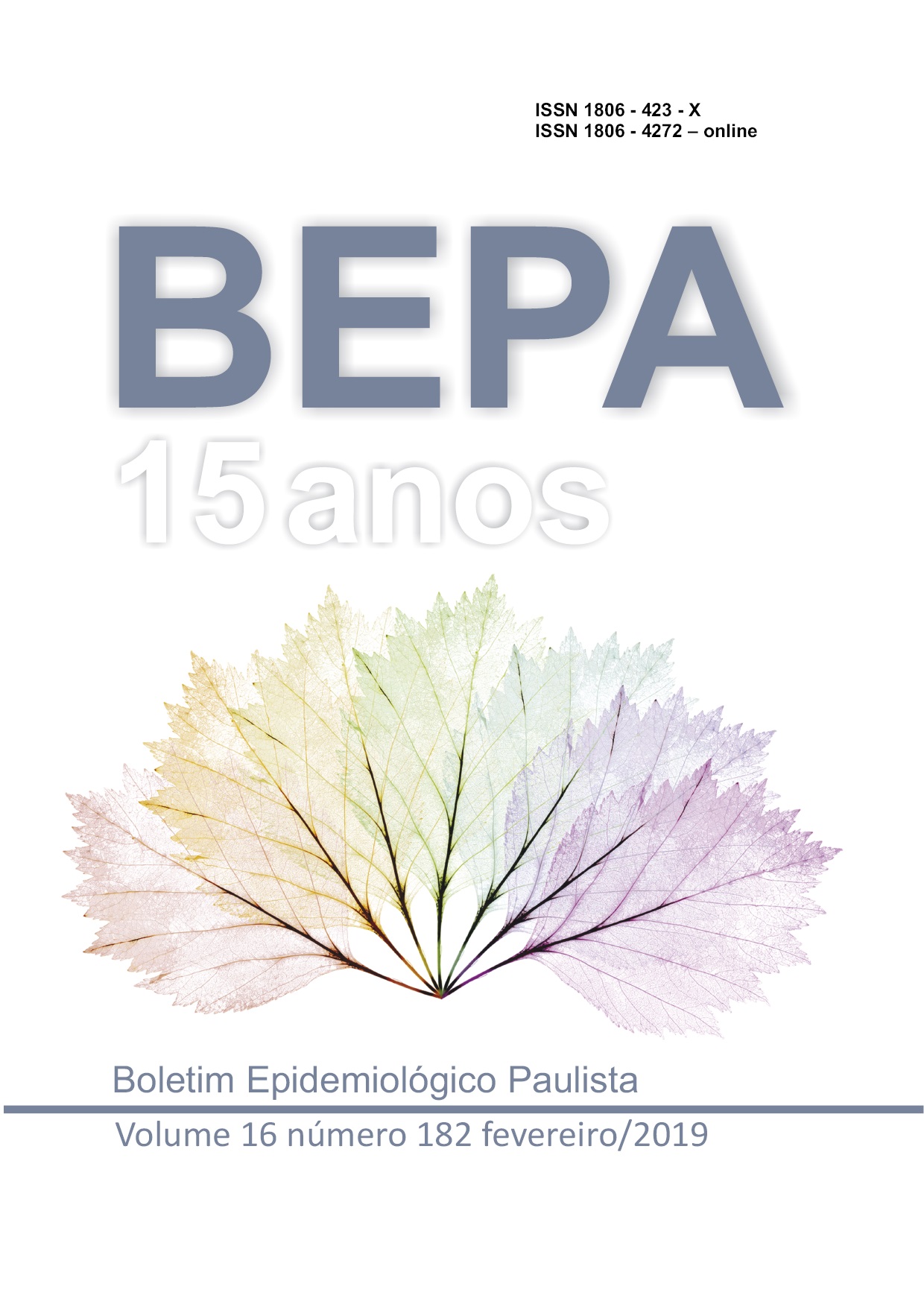Abstract
This study aimed at evaluating the profile of enteropathogens isolated from children
under 5 years of age, during the occurrence of cases of diarrhea in the institutions of four
municipalities in the State of São Paulo in 2015 and 2016. Feces samples were collected
from 107 children, 78 (72.9%) with diarrhea and 29 (27.1%) without. The employed
methodologies were copro-culture, bacterial identification and antimicrobial susceptibility
testing. Forty-six (46%) of 107 clinical samples presented growth of enteropathogens.
Enteropathogenic Escherichia coli (EPEC), enteroaggregative Escherichia coli (EAEC)
and Salmonella enterica subsp houtenae were the mostly frequent isolated from children.
Of the total number of the studied children, three of them presented co-infection with
two etiological agents: EPEC/EAEC and Salmonella enterica subsp houtenae/EAEC. The
highest occurrence among the isolated etiologic agents was EPEC (24/49, 49%), followed
by EAEC (14/49, 28.6%). Two EPEC strains belonged to the O109:H21 serotype were
sensitive to the tested antimicrobials, whereas two belonging to the O156:H1 serotype
were resistant to gentamicin and amicacin and streptomycin, respectively. Two EAEC
strains of the same serotype O80:H10 and two EAEC O15:H2 presented multi-resistance at
least to nalidixic acid, sulfamethoxazole and tetracycline. It may suggest that the children
attending three different institutions, who had clusters of cases of diarrhoea carried the
bacterial clones of EPEC or EAEC strains, because they belonged to the same serotype
and show a similar sensitivity profile. The results found in the present study are worrying
and they show that the constant antimicrobial epidemiological surveillance should be
ensured for monitoring the emergence of resistant clones, and for establishing strategies
for preventing and controlling the outbreaks and epidemics.
References
Spano, et al. High prevalence
of diarrheagenic Escherichia coli
carrying toxin-encoding genes
isolated from children and adults
in Southeastern Brazil. BMC
infect.dis. 2017; 17:773.
Brasil. Ministério da Saúde. [CVE] Centro
de Vigilância Epidemiológica “Prof.
Alexandre Vranjac”. Monitorização das
doenças diarreicas agudas - normas e
instruções. São Paulo. 2008; 1-55.
Trabulsi LB, Alterthum F. Microbiologia.
São Paulo: Atheneu. 4. ed; 2004.
World Health Organization (WHO). The
Management and prevention of diarrhea:
practical guidelines. Geneva: WHO; 2005.
Gomes TAT, et al. Diarrheagenic
Escherichia coli. Braz. j.
microbiol. 2016; 47: 3-30.
Kaper JB, Nataro JP, Mobley HLT.
Pathogenic Escherichia coli. Nat.
rev. microbiol. 2004; 2: 123-40.
Nataro JP, Kaper JB. Diarrheagenic
Escherichia coli. Clin. Microbiol.
rev. 1998;11(1):142-201.
Brasil. Ministério da Saúde. [CVE]
Centro de Vigilância Epidemiológica
“Prof. Alexandre Vranjac”. Vigilância
epidemiológica das doenças transmitidas porágua e alimentos: Investigação de surtos -
normas e instruções. São Paulo. 2008; 7-13.
Graciaa et al. Outbreaks Associated with
Untreated Recreational Water - United
States, 2000–2014. MMWR morb.
mortal. wkly. rep. 2018; 67(25):701-6.
Peresi JTM, et al. Search for
diarrheagenic Escherichia coli in raw
kibbe samples reveals the presence
of Shiga toxin-producing strains.
Food control. 2016; 63:165-70.
Ewing WH. Edwards and Ewing’s
Identification of Enterobacteriaceae, 4.ed.
Elsevier Science Publishers. 1986.
World Organisation for Animal Health.
Campylobacter jejuni and Campylobacter
coli [internet]. In: OIE Terrestrial
Manual. 2008. [acesso em 3 nov. 2018].
Disponível em: http://www.oie.int/
fileadmin/Home/eng/Health_standards/
tahm/2.09.03_CAMPYLO.pdf
Bauer AW, et al. Antibiotic
susceptibility testing by a standardized
single disk method. Am. J. clin.
pathol. 1966; 45: 493-6.
Bonkoungou IJ, et al. Bacterial and
viral etiology of childhood diarrhea
in Ouagadougou, Burkina Faso.
BMC pediatr. 2013, 13(36):1-6.
Piralla A, et al. FilmArray™ GI
panel performance for the
diagnosis of acute gastroenteritis
or hemorragic diarrhea. BMC
microbiol. 2017; 17:1-10.
Omulo S, et al. A review of 40 years of
enteric antimicrobial resistance research
in Eastern Africa: what can be done
better? Antimicrobial Resistance and
Infection Control. 2015; 4:1-13.
Clayton DA, Griffith CJ, Price P,
Peters AC. Food handlers’ beliefs
and self-reported practices. Int. j.
environ. health res. 2002; 12:25-39.

This work is licensed under a Creative Commons Attribution 4.0 International License.
Copyright (c) 2019 Andréia Moreira dos Santos Carmo, Fernanda Miranda Lima, Flávia de Paulo Daurelio, Elisa Ribeiro Mucci, Cintia Mayumi Ahagon, Luis Fernando dos Santos, Monique Ribeiro Tiba-Casas, Maria Cecilia Cergole-Novella




